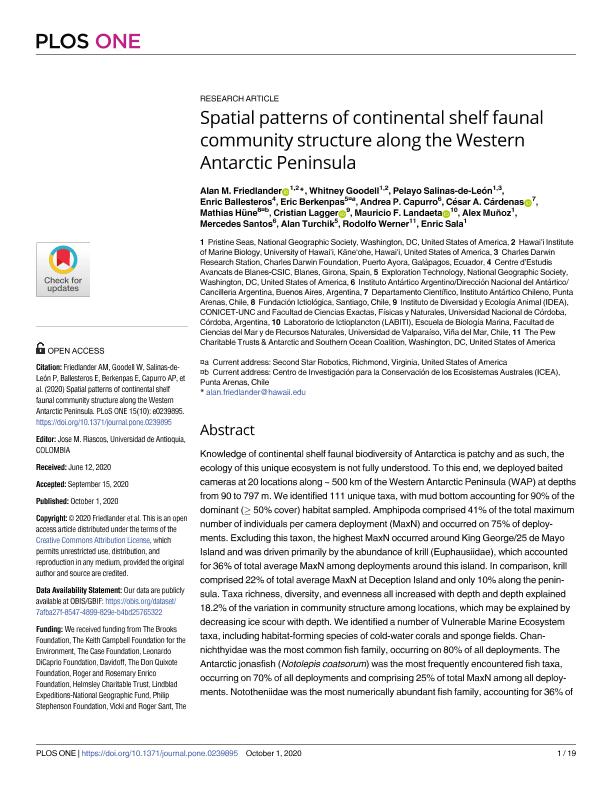Artículo
Spatial patterns of continental shelf faunal community structure along the Western Antarctic Peninsula
Friedlander, Alan M.; Goodell, Whitney; Salinas-De-León, Pelayo; Ballesteros, Enric; Berkenpas, Eric; Capurro, Andrea Paula; Cárdenas, César; Hüne, Mathias; Lagger, Cristian Fabian ; Landaeta, Mauricio F.; Muñoz, Alex; Santos, Mercedes; Turchik, Alan; Werner, Rodolfo; Sala, Enric
; Landaeta, Mauricio F.; Muñoz, Alex; Santos, Mercedes; Turchik, Alan; Werner, Rodolfo; Sala, Enric
 ; Landaeta, Mauricio F.; Muñoz, Alex; Santos, Mercedes; Turchik, Alan; Werner, Rodolfo; Sala, Enric
; Landaeta, Mauricio F.; Muñoz, Alex; Santos, Mercedes; Turchik, Alan; Werner, Rodolfo; Sala, Enric
Fecha de publicación:
01/10/2020
Editorial:
Public Library of Science
Revista:
Plos One
e-ISSN:
1932-6203
Idioma:
Inglés
Tipo de recurso:
Artículo publicado
Clasificación temática:
Resumen
Knowledge of continental shelf faunal biodiversity of Antarctica is patchy and as such, the ecology of this unique ecosystem is not fully understood. To this end, we deployed baited cameras at 20 locations along ~ 500 km of the Western Antarctic Peninsula (WAP) at depths from 90 to 797 m. We identified 111 unique taxa, with mud bottom accounting for 90% of the dominant (≥ 50% cover) habitat sampled. Amphipoda comprised 41% of the total maximum number of individuals per camera deployment (MaxN) and occurred on 75% of deployments. Excluding this taxon, the highest MaxN occurred around King George/25 de Mayo Island and was driven primarily by the abundance of krill (Euphausiidae), which accounted for 36% of total average MaxN among deployments around this island. In comparison, krill comprised 22% of total average MaxN at Deception Island and only 10% along the peninsula. Taxa richness, diversity, and evenness all increased with depth and depth explained 18.2% of the variation in community structure among locations, which may be explained by decreasing ice scour with depth. We identified a number of Vulnerable Marine Ecosystem taxa, including habitat-forming species of cold-water corals and sponge fields. Channichthyidae was the most common fish family, occurring on 80% of all deployments. The Antarctic jonasfish (Notolepis coatsorum) was the most frequently encountered fish taxa, occurring on 70% of all deployments and comprising 25% of total MaxN among all deployments. Nototheniidae was the most numerically abundant fish family, accounting for 36% of total MaxN and was present on 70% of the deployments. The WAP is among the fastest warming regions on Earth and mitigating the impacts of warming, along with more direct impacts such as those from fishing, is critical in providing opportunities for species to adapt to environmental change and to preserve this unique ecosystem.
Palabras clave:
ANTARCTICA
,
BENTHO
,
DEEP FAUNA
Archivos asociados
Licencia
Identificadores
Colecciones
Articulos(IDEA)
Articulos de INSTITUTO DE DIVERSIDAD Y ECOLOGIA ANIMAL
Articulos de INSTITUTO DE DIVERSIDAD Y ECOLOGIA ANIMAL
Citación
Friedlander, Alan M.; Goodell, Whitney; Salinas-De-León, Pelayo; Ballesteros, Enric; Berkenpas, Eric; et al.; Spatial patterns of continental shelf faunal community structure along the Western Antarctic Peninsula; Public Library of Science; Plos One; 15; 10; 1-10-2020; 1-19
Compartir
Altmétricas



